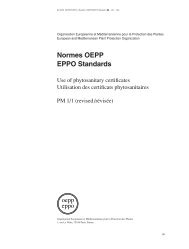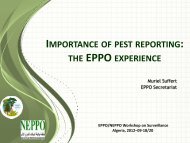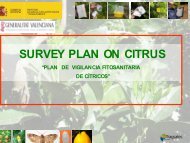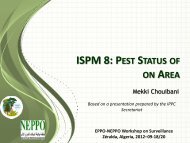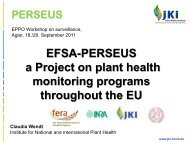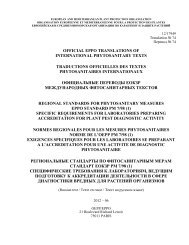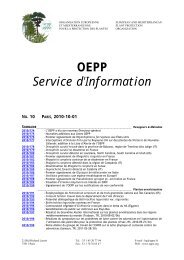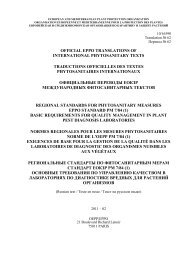EPPO Reporting Service - Lists of EPPO Standards - European and ...
EPPO Reporting Service - Lists of EPPO Standards - European and ...
EPPO Reporting Service - Lists of EPPO Standards - European and ...
You also want an ePaper? Increase the reach of your titles
YUMPU automatically turns print PDFs into web optimized ePapers that Google loves.
<strong>EPPO</strong> <strong>Reporting</strong> <strong>Service</strong> – Pests & Diseases<br />
2010/011 Marchalina hellenica found on the Isl<strong>and</strong> <strong>of</strong> Procida, Italy<br />
The NPPO <strong>of</strong> Italy informed the <strong>EPPO</strong> Secretariat that Marchalina hellenica (Hemiptera:<br />
Margarodidae – formerly <strong>EPPO</strong> Alert List) has been recorded on the Isl<strong>and</strong> <strong>of</strong> Procida<br />
(province <strong>of</strong> Napoli, Campania region). So far, M. hellenica was only present on the nearby<br />
Isl<strong>and</strong> <strong>of</strong> Ischia (see <strong>EPPO</strong> 2006/130). On Procida, M. hellenica was found in only 1 Pinus<br />
taeda tree which has now been destroyed. Further surveys carried out on the isl<strong>and</strong> did not<br />
detect the pest. It is considered that this isolated finding resulted from natural spread<br />
from the nearby Isl<strong>and</strong> <strong>of</strong> Ischia where the pest is now established.<br />
Source: NPPO <strong>of</strong> Italy, 2009-12.<br />
Additional key words: detailed record Computer codes: MARCHE, IT<br />
2010/012 Chrysomphalus aonidum is reported from Calabria, Italy<br />
The NPPO <strong>of</strong> Italy recently informed the <strong>EPPO</strong> Secretariat that Chrysomphalus aonidum<br />
(Hemiptera: Diaspididae – Florida red scale) has been found in Calabria region. In July<br />
2009, the Regional PPO <strong>of</strong> Calabria detected C. aonidum in the municipality <strong>of</strong> Bianco,<br />
Province <strong>of</strong> Reggio Calabria. The pest was observed on leaves <strong>and</strong> fruits <strong>of</strong> citrus plants<br />
(Citrus limon, C. reticulata, Fortunella japonica) in private urban areas. Surveys are being<br />
implemented in the surrounding areas to determine the extent <strong>of</strong> the infestation. An<br />
eradication programme is currently being developed by the Regional PPO <strong>of</strong> Calabria.<br />
The pest status <strong>of</strong> Chrysomphalus aonidum in Italy is <strong>of</strong>ficially declared as: Present, one<br />
isolated outbreak.<br />
Note: C. aonidum is considered to originate from Asia but it has become widely distributed<br />
in tropical <strong>and</strong> subtropical regions <strong>of</strong> the world. It is a highly polyphagous pest (feeds on<br />
more than 270 species from 69 plant families) but the most significant damage is observed<br />
on citrus. In the <strong>EPPO</strong> region, C. aonidum has been recorded around the Mediterranean<br />
Basin on citrus in Algeria, Egypt, Israel, Lebanon, Morocco, Spain (Islas Canarias only),<br />
Greece, <strong>and</strong> Turkey. In other <strong>European</strong> countries (e.g. France, Hungary, Netherl<strong>and</strong>s,<br />
Pol<strong>and</strong>), it is occasionally reported on ornamental plants grown in glasshouses.<br />
In Italy, the presence <strong>of</strong> C. aonidum had been observed earlier but only in protected<br />
conditions. It was observed in Sicilia on Cycas spp. in 1994 <strong>and</strong> later on Kentia <strong>and</strong><br />
Dracaena in glasshouses. It was detected outdoor on citrus for the first time in spring 2006<br />
in Calabria. It was observed on Citrus aurantium grown for ornamental purposes in the<br />
centre <strong>of</strong> the municipality <strong>of</strong> Bianco (same location as in 2009). Other citrus trees growing<br />
in private gardens nearby were also infested. Interestingly, the presence <strong>of</strong> C. aonidum on<br />
outdoor citrus trees is also rather recent in Greece (2000) <strong>and</strong> Spain (1999). In mainl<strong>and</strong><br />
Spain, C. aonidum was first detected on outdoor citrus near Valencia in 1999, but the pest<br />
was successfully eradicated from this region (however, it is still recorded as present from<br />
Islas Canarias).<br />
Source: NPPO <strong>of</strong> Italy, 2009-10.<br />
García Marí F, Soto A, Hernández Penadés P, Rodrigo E, Rodríguez Reina (2000) Una<br />
nueva cochinilla aparece en los cítricos valencianos, Chrysomphalus aonidum.<br />
Phytoma España no. 117, 35-40.<br />
Germain JF, Matile-Ferrero D (2005) Les cochenilles sous serres en France:<br />
inventaire illustré. III – Les Diaspididae. Phytoma - La Défense des Végétaux no.<br />
583, 32-35.<br />
14




